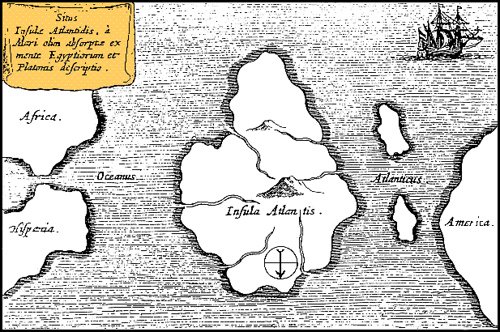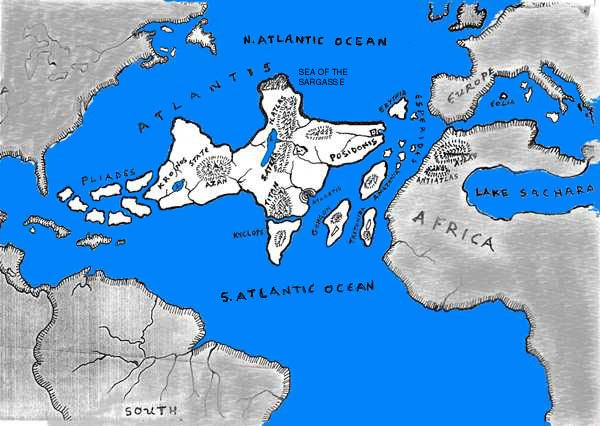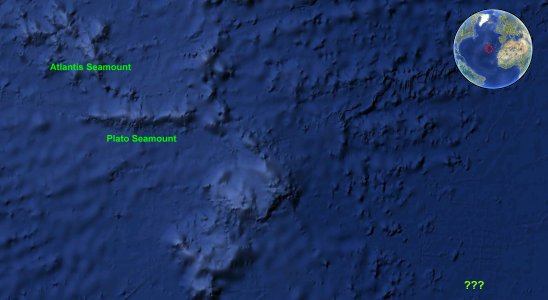
The Lost Civilization of Atlantis
 The
highly influential ancient Greek philosopher Plato (see image on the
right) wrote in the year
360 BC about Atlantis in his dialogues "Timaeus" and "Critias." In
these dialogues it was told by the character Critias that his
grandfather heard about the story of Atlantis hundred years ago from
Solon; A well-known
Athenian poet and politician (statesman). In the year 565 BC, Solon
heard about the
story during his stay in the city of Saïs in Egypt,
from the priests of the goddess Neith. A very aged priest - who ancient
Greek historians later identified as Sonchis of Saïs
- told him that, from that time some 9,000 years ago, "Athens" (the
city or the area that we know today as Athens) had been in conflict
with the great power of Atlantis, which was then destroyed in a
catastrophe.
The
highly influential ancient Greek philosopher Plato (see image on the
right) wrote in the year
360 BC about Atlantis in his dialogues "Timaeus" and "Critias." In
these dialogues it was told by the character Critias that his
grandfather heard about the story of Atlantis hundred years ago from
Solon; A well-known
Athenian poet and politician (statesman). In the year 565 BC, Solon
heard about the
story during his stay in the city of Saïs in Egypt,
from the priests of the goddess Neith. A very aged priest - who ancient
Greek historians later identified as Sonchis of Saïs
- told him that, from that time some 9,000 years ago, "Athens" (the
city or the area that we know today as Athens) had been in conflict
with the great power of Atlantis, which was then destroyed in a
catastrophe.
The name "Atlantis" (and also the other names he mentions in regards to Atlantis) is actually a Greek translation of the Egyptian name to maintain the original meaning of the actual name, because the Egyptian name would also have been a translation to the ancient Egyptian language. It is however unknown by which name Atlantis would have been known by the ancient Egyptians.
Plato's dialogues tell us that before the advanced Greek
civilization, there once was another highly advanced civilization
called "Atlantis", and was a huge island that was larger
than (former) Libya (North-Africa) and Asia (Asia Minor) put
together. Plato's account is regarded by many as the most credible
account of a possible ancient lost civilization.
Quoted from
Plato's "Timaeus" (21a-27b):
"Now in this island of Atlantis there was a great and wonderful empire which had rule over the whole island and several others, and over parts of the continent, and, furthermore, the men of Atlantis had subjected the parts of Libya within the columns of Heracles as far as Egypt, and of Europe as far as Tyrrhenia. [todays Etruria]"
Atlantis was situated beyond the "Columns of
Heracles", also known as the Pillars/Columns of Hercules
and is known today as the Strait
of Gibraltar). If one travels from the Mediterranean Sea beyond
the Strait of Gibraltar one will find themselves within the vast
Atlantic Ocean. For generations its people lived virtuous lives until
greed and power began to corrupt them. The final destruction of
Atlantis happened some 9,500 years before Plato's time, when the land
disappeared in the depths of the sea due to violent earthquakes and
floods.
The dialogue "Timaeus" mentioned that, during
Plato's time, there was an impassable and impenetrable shoal of
mud in these parts of the sea that was caused by the subsidence of
the island. There are many scholars today who believe that Plato's
story about Atlantis was merely a fictional account, a possible
metaphor, because there is no known land or civilization which fits
its descriptions. However, both dialogues "Timaeus"
and "Critias"
seem to implicate a purely historical account with so much detail
that would be quite unnecessary for merely a metaphor.
In the
dialogue "Critias" Plato wrote that Atlantis was founded by
Poseidon - known in Greek mythology as "the god of the sea"
- who did fell in love with a mortal woman named Cleito. Cleito gave
birth to five sets of twin boys, and the domain was divided among
them. The eldest, named Atlas, became the first king of Atlantis. In
Greek mythology Atlas was the bearer of the heavens, and Greek
historian Herodotus mentioned that Atlas was in fact a lofty mountain
that by the Atlantean natives was seen as the pillar of the heaven.
From paragraph 184 from Heredotus' "Histories":
"After
this at a distance of ten days' journey there is another hill of salt
and spring of water, and men dwell round it. Near this salt hill is a
mountain named Atlas, which is small in circuit and rounded on every
side; and so exceedingly lofty is it said to be, that it is not
possible to see its summits, for clouds never leave them either in
the summer or in the winter. This the natives say is the pillar of
the heaven. After this mountain these men got their name, for they
are called Atlantians; and it is said that they neither eat anything
that has life nor have any dreams."
Poseidon had his own temple within the citadel of Atlantis
City. Its exterior was entirely covered with silver and its pinnacles
with gold, and the interior of the temple was of ivory, gold, silver,
and an legendary material called "orichalch" (or
orichalcum) which appeared to shone like fire, even to the pillars
and floor.
Today most scholars agree orichalcum would have
been a brass-like alloy, which was made in antiquity by cementation.
This process was achieved with the reaction of zinc ore, charcoal and
copper metal in a crucible. During early 2015, divers had recovered
39 ingots from a ship that sunk some 2,600 ago off the coast of
Sicily. Analyzed with X-ray fluorescence, these ingots turned to be
an alloy made with 75 to 80 percent copper, 15 to 20 percent zinc and
small percentages of nickel, lead and iron. Therefore it is possibly
that this material could be the legendary material orichalch.
The
temple contained a colossal statue of Poseidon standing in a chariot
drawn by six winged horses, about him a hundred Nereids riding on
dolphins. Arranged outside the building were golden statues of the
first ten kings and their wives. Because of the excessive use
of noble metals within the large construction, the description of the
temple of Poseidon seems similar to the description of the
"Valhalla" from Norse mythology, which had
been described in the Poetic Edda as appearing shining and
golden. According to the Vikings, Valhalla was the domain of the
god Odin, and a kind of heaven for the slain soldiers which were
brought to him by the Valkyries (Odin's warrior maiden). It seems
that the mythologic place "Asgard"; the residence of the
gods, was in fact Atlantis City as described by Plato. It is also
reminiscent of of the temple of the "LORD", as described in
the apocryphic book: "The Book of Enoch". In chapter
14:8-23 of the book this temple is described with an interior
and a floor made out of crystal stones, where the roof appeared like
agitated stars and flashes of lightning, where a flame burned around
its walls, and where its portal blazed with fire. Perhaps this wasn't
really fire but merely the reddish shimmering of the material
orichalc.
As Plato mentioned in his dialogues that one was
already familiar with the god Poseidon during the Atlantean
times it probably means that the origins of Greek mythology were much
older than the Greek civilization itself (as we know it today) and
therefore they could be traced back to the age of the civilization of
Atlantis. Could it be that these origins of Greek mythology, these
testimonies from Atlantis, could have been spread to other parts of
the world where it was passed on from where it ultimately took the
form of the Greek, Norse and ancient Mesopotamian mythologies?
On
the island Santorini (classically named Thera), which like Crete was
part of the Greek archipelago, there would have been a devastating
earthquake and a volcanic eruption around 1628 BC. Although some
think that Plato described the demise of this island, he explicitly
mentioned that Atlantis was situated past the Columns of Heracles,
which marks the beginning of the Atlantic Ocean, when sailing
from Greece. Also, the period of the demise of Santorini (between
1627-1600 BC) doesn't match the period of the demise of Atlantis
which Plato mentioned.

Kircher's
map of Atlantis from the time frame around 10,000 BC
Athanasius Kircher (1601-1680), a renaissance man very much like Leonardo da Vinci, made a map (seen above) based on Plato's descriptions in his book "Mundus Subterraneus" (The Underground World) in ca. 1665. (Note that north is shown down and south is shown up.)

Vasilis
Pashos' map of the whole continent of Atlantis during
its much earlier times
(Possibly
around 20,000 BC)
The map shown above had been drawn in the year 1979
by writer and researcher Vasilis Pashos, founder of the Atlantis
Museum in Athens. It is based on ancient data of, among others; Plato ("Timaeus" and "Critias"), Diodoros
Sikeliotis ("Historic Bookcase"), Poseidonios (Kikeron's
teacher), and the work: "Collection of travelers'
narrations" by the geographer Marchellus.

Atlantis Seamount, Plato
Seamount and the grid pattern right-below
(Click image to enlarge)
Today there are two sea mounts named after both Atlantis and
Plato; the "Atlantis Seamount", and the "Plato
Seamount" (seen above) which are possibly described in his
dialogs. (See the coordinates: 33
28'N, 28 39'W at Google Maps or Google Earth.) Google's
world map, based on satellite images and bathymetric data, shows
since the images from 2009 also a grid of lines that is situated a
little eastward from these sea mounts. According to a Google
spokesman these lines would be errors which would be corrected in the
upcoming image data from 2012, but when this data emerged one could
still see the very same grid pattern, although somewhat less
noticeable because of the lower image quality and cleared out image
data compared to the image data from 2011.
Perhaps they think it must be an error because they simply could not believe it? There doesn't seem to be any good reason to exclude the possibility without any doubt that these couldn't be some kind of remnants from a sunken ancient civilization while on the other hand it is located near a place that Plato possibly could have been described in his dialogues. (See the chapter: "Geographic Evidence" for more information about this peculiar grid pattern.)
More (possible) references to Atlantis by historians and other sources:
Many ancient writings and stories from Greece, Egypt, the
Mayans and the Aztecs, the Basques from Spain, the Gauls from France,
the tribes of the Canary and Azores islands, the Frisians from the
Netherlands, and many Amerindian tribes all speak of their origins
from a large sunken land within the region of the Atlantic Ocean.



